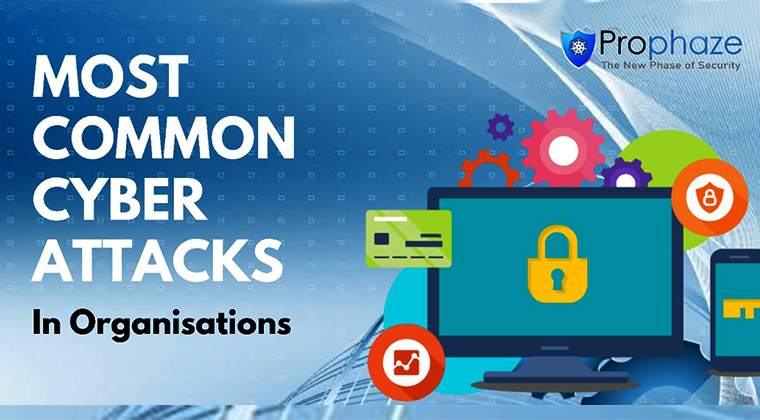Most Common Cyber Attacks You Must Be Aware of!!!

Cyber attacks are one of the fastest-growing crimes in the cyber world. Cyberspace has become a major force in today's online business world and has attracted many crooks who wish to steal company or individual data and confidential corporate information. A cyber attack is any malicious act that attacks computer networks, computer systems, infrastructures, computers, or personally-owned computer devices.
When cyberattacks target a company, the attack usually begins with an attempt to gain access to a company's network or data. Once the hacker has gained access, they typically perform a variety of common attacks, which include data mining, file and program manipulation, security testing, system scanning, and application execution. After the attack has been successfully executed on the targeted system, they will then attempt to exploit the target's operating system and other applications in order to extract confidential information. In order to stop cyberattacks from occurring on your computer, it's essential that you're able to identify common types of cyberattacks.
Let’s discuss some most common cyber attacks in detail:
1. Malware
One of the most common types of cyber security attacks is a "malware" attack. Malware is a generic term that does describe any virus, worm, Trojan horse, or another type of malware that surreptitiously installs itself on your computer and then performs a number of different malicious functions. The prime goal of these types of attacks is to corrupt or damage files and folders on your computer in order to effectively hide from you and/or make it appear that your PC is infected by a large number of virus programs when it's really just one or two rogue programs. No matter what kind of malware attack you're dealing with, it's always important that you're able to recognize it and remove it quickly before it causes more harm than it fixes.
2. SQL Injection
SQL injection is a well-known open-source vulnerability that allows a remote user to execute arbitrary SQL commands with the aim of arbitrary command execution. SQL injection is often used by programmers to gain access to database information. SQL injections are extremely powerful because they allow an attacker to create new administrative users without securing the server against future attacks. This means that SQL injection can allow an attacker to run arbitrary PHP scripts on your website, retrieve email contents, change online behavior and even capture screenshots of your website. There are many common ways an attacker could use SQL injection to execute SQL queries under the wrong hands. The most common way is through PHP scripts, which are commonly abused to carry out SQL injection attacks.
3. Phishing
Phishing refers to a style of cyber-intrusion that attacks a computer network by impersonating a genuine security service or product. The modus operandi consists of a series of carefully orchestrated attacks with the aim of stealing financial or personal data. Phishing has often been used in order to trick users into clicking or downloading harmful programs. It has also been used in order to carry out targeted scams and to gather user information for spamming purposes. A phishing scam will typically require the user's private details, such as their password or social networking account information. In many cases, phishing emails are delivered to the target's inbox, falsely claiming that they are from a trusted source or organization.
4. Man-in-the-Middle (MitM) Attack
A MITM attack is a malicious attack, often initiated by an unsuspecting victim, in which an attacker sends a spoofed automated email message to a targeted victim, typically with the intent of tricking the recipient into authorizing access to a specific program or file. The attacker can then use the information obtained to gain access to the target computer and perform any number of malicious activities, ranging from data theft to malicious network intrusion. A possible outcome of a man-in-the-middle attack includes the theft of a local user ID and password, modification of a website's URL, unauthorized downloading of media files, or simply a simple command injection in legitimate Internet activity.
5. Denial-of-Service (DoS) Attack
A denial of service attack is a powerful form of cyber espionage and cyber warfare in which the attacker seeks to create or destroy a network or computer resource unavailable to its victims, usually by either temporarily or permanently disabling services of such a host. The attacker may do this by running a dos-exception or dos-lock on a system file or by using an infected program that runs a dos-virus program to spoof a security program or other type of protection mechanism on a system or computer. A Denial of Service attack can get extremely debilitating for the victim because it blocks access to a computer system and may deny the user access to data that may be vital to a normal operation of the computer system.
6. Zero-Day Exploit
A zero-day exploit is a computer-code vulnerability that has not been patched or identified to users of the operating system or applications that make use of the code. This kind of vulnerability allows attackers to gain unauthorized access to a computer system without triggering any alarms or notifications. Hackers can then use this information to execute programs on behalf of the user, corrupt data, take over a network, or cause a wide array of system conditions that may require immediate administration to fix.
7. DNS Tunneling
DNS Tunneling is a way of attack which encapsulates the data of various protocols or systems in DNS responses and queries. In simple terms, DNS Tunneling refers to a way of creating a dummy server on which the attacker stores the data instead of the real server. The data being passed through the DNS tunneling is then copied onto another system, such as the victim machine. Hence, DNS Tunneling attacks the integrity of DNS. DNS Tunneling can also be done for the purpose of redirecting or spoofing. This means that instead of the original IP address of the client getting modified, a new IP address is obtained by tunneling.
8. Rootkits
A rootkit, in computer parlance, is actually a set of malicious software designed primarily to allow access to a specific area or a part of its coded software and, in many cases, masks its presence or even the presence of other harmful software. The word rootkit is really a combination of two words, namely "root" and "kit." This malicious activity may also conceal itself as a simple program that runs in the background, or it may automatically perform various activities on the computers being infected. Once these activities are started, they tend to cause all sorts of damage to the operating system of the infected computer in several ways.
9. Cross-Site Scripting
Cross-site scripting is an inherent kind of security vulnerability that is present in any web application. It allows attackers to inject server-side scripts into web pages visited by other clients. Moreover, an attacker can use this script injection to bypass access restrictions such as the Same Origin Policy. The most common method of cross-site scripting attack is through embedded user input. When an unsuspecting web user inputs a form for inputting values such as credit card numbers, an attacker could use this user input to bypass authorization and gain unauthorized access to a website. Most users are aware that they are not authorized to enter sensitive information on websites unless they've been explicitly authorized to do so, but inexperienced users may not understand that cross-site scripting attacks could allow unauthorized access to their web page.
10. Password Attack
A password attack is a type of malware that enables hackers to automatically guess popular passwords, even when the password has been changed. These attacks are usually facilitated through the usage of automated software, which either solves or facilitates the cracking of passwords. In many cases, they are also used by phishers who use fake password reset programs and email the user a new password which is easy to crack. It is therefore important for all computer users to be on their guard and prevent password attacks. There are three most common forms of password attacks: phishing attack, dump attack, and counter attack. This attack occurs when a hacker takes advantage of an innocent website in order to send confidential information or access and control information from a computer system.
The Final Say
Being attentive in the age of cyber-attacks is one of the most important things that you can learn, especially if you're a young person working in a corporate environment. The truth of the core is that cyberattacks aren't only happening to old people who stay online all day. The fact is that it has been happening to younger people just like you and me for quite some time.
The apt way to stay safe and secure when you are online is to use common sense. You require to be mindful of what you are doing and who you are with. The Internet is not a place where you should be giving out a lot of personal information. As strange as it sounds, cyberattacks are becoming more popular among younger people. The best thing that you can do for yourself is to take the necessary precautions as it is your first dot of defense against them.


